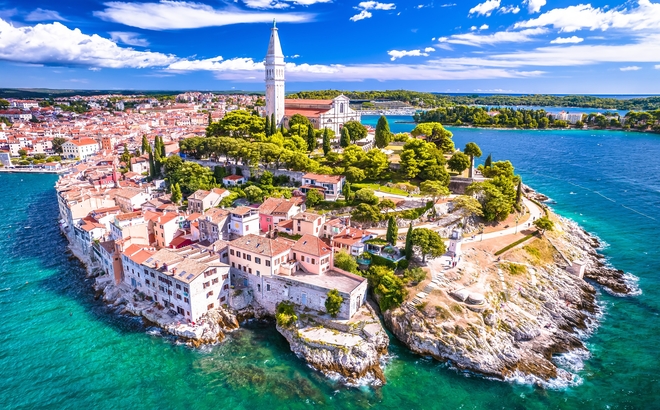Rovinj, Croatia: Know Before You Go

Nicknamed the "Pearl of Istria" for the Adriatic peninsula it inhabits, the small town of Rovinj is popular for relaxation and water activities, as well as wilderness and a rich history. Here you can learn why Rovinj is so charming and get all the information you need to plan a successful trip!
Rovinj - the Pearl of Istria
Nestled between the crystal-clear waters of the Adriatic Sea and the green hills of Croatia's Istria region, Rovinj is a small, beautiful coastal town. With its tangle of cobbled streets, colorful facades and lively harbor atmosphere, this enchanting destination attracts travelers in search of an authentic experience.
Rovinj must-sees include:
The Church of Saint Euphemia. Built in the 18th century above the Rovinj old town, this Baroque church is an architectural marvel. Inside, visitors can admire its treasures, including superb works of religious art from the city's golden age. From the top, they can enjoy panoramic views of the Adriatic Sea and surrounding islands.
The Rovinj beaches. Where can you swim in Rovinj? The town of Rovinj is surrounded by miles of heavenly beaches. Punta Corrente beach (or Golden Cape beach) stands out for its beauty, crystal-clear waters, shady pines and craggy rocks. It's a great place for snorkeling. Lone Bay beach, with its peaceful ambience and preserved coastal landscape, is another gem of Rovinj. Finally, don't miss Baluota beach. Accessible on foot from the old town of Rovinj, this small, landscaped cove offers unique views.
The Zlatni Rt Natural Park. Also known as the Golden Cape, Zlatni Rt Forest Park is a true natural wonder. On the shores of the Adriatic Sea, lush Mediterranean landscapes and breathtaking rocky coastlines combine to delight nature lovers and adventurers in search of authentic natural beauty. You can enjoy secluded beaches where you can admire the marine life and have lunch at one of the shaded picnic areas.
And don't forget to watch the sunset in Rovinj! This port city on the west coast of Croatia is a prime spot for admiring magical sunsets! Where can you see the sunset in Rovinj? Two spots stand out: the port of Rovinj and "the bunker" near the old town.
Visiting Rovinj - Useful Information
Rovinj Weather
Rovinj has a typical Mediterranean climate with hot, sunny summers and mild, wet winters. During the summer season, from June to September, there are plenty of sunny days and temperatures approach 30 degrees. The weather is perfect for strolling through the cobbled streets of Rovinj's old town, enjoying the picturesque beaches of the Adriatic coast and exploring the surrounding nature.
Getting Around Rovinj
Only 40 kilometers away, the international airport of Pula (capital of Istria) is the closest airport to Rovinj. You can get there in 45 minutes by bus (5 to 10 euros) or by rental car.
In Rovinj, points of interest are close enough to each other so that you won’t need to rent a car. If you don’t mind walking, you can get around on foot, but to optimize travel time and widen your radius, there's nothing better than a bicycle! Visit one of the city's many bike rental companies.
Do I Need a Visa for Rovinj?
In 2023, Croatia joined the Schengen Area. It has become the 27th state in this area of free movement of people in Europe, and foreign travelers from certain countries who wish to enter Croatia now require a Schengen visa.
Are you a citizen of the European Union or Schengen Area (or Associated States)? No need for a visa. You can travel to Rovinj (Croatia) with a national identity card or passport valid for the duration of your stay.
Are you a citizen of a country outside the EU and Schengen Area? Depending on your nationality, you may need a visa to travel to Croatia, even for a short trip for tourism. See whether your country is on the Schengen visa-free list or not here.
How Do I Get a Schengen Visa?
Do you need a Schengen visa to travel to Croatia? Go to the Croatian consulate's website for your country of residence to find the information you will need and start your Schengen visa application. Please note: if you wish to visit several countries in the Schengen Area, you must specify this in your application.
Once you have obtained your Schengen visa, be sure to keep your supporting documents with you, including your proof of insurance covering medical and hospital expenses for a minimum of €30,000. The border police may request them when you enter the Schengen Area.
Which Schengen Visa Insurance Should You Choose?
Choose peace of mind for your Schengen visa application and when crossing the border with Schengen travel insurance policies from Europ Assistance.
Starting at 3 euros, Europ Assistance's Schengen visa travel insurance covers you for medical expenses of up to €60,000 in the event of illness or accident, as well as additional coverage in all Member States of the Schengen Area and European Union (as well as the United Kingdom).
Apply online and get your proof of insurance immediately, recognized and accepted by Schengen embassies and consulates worldwide.
